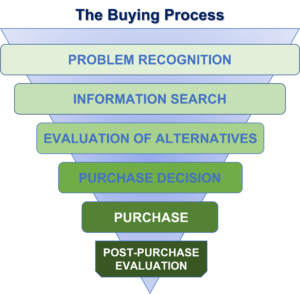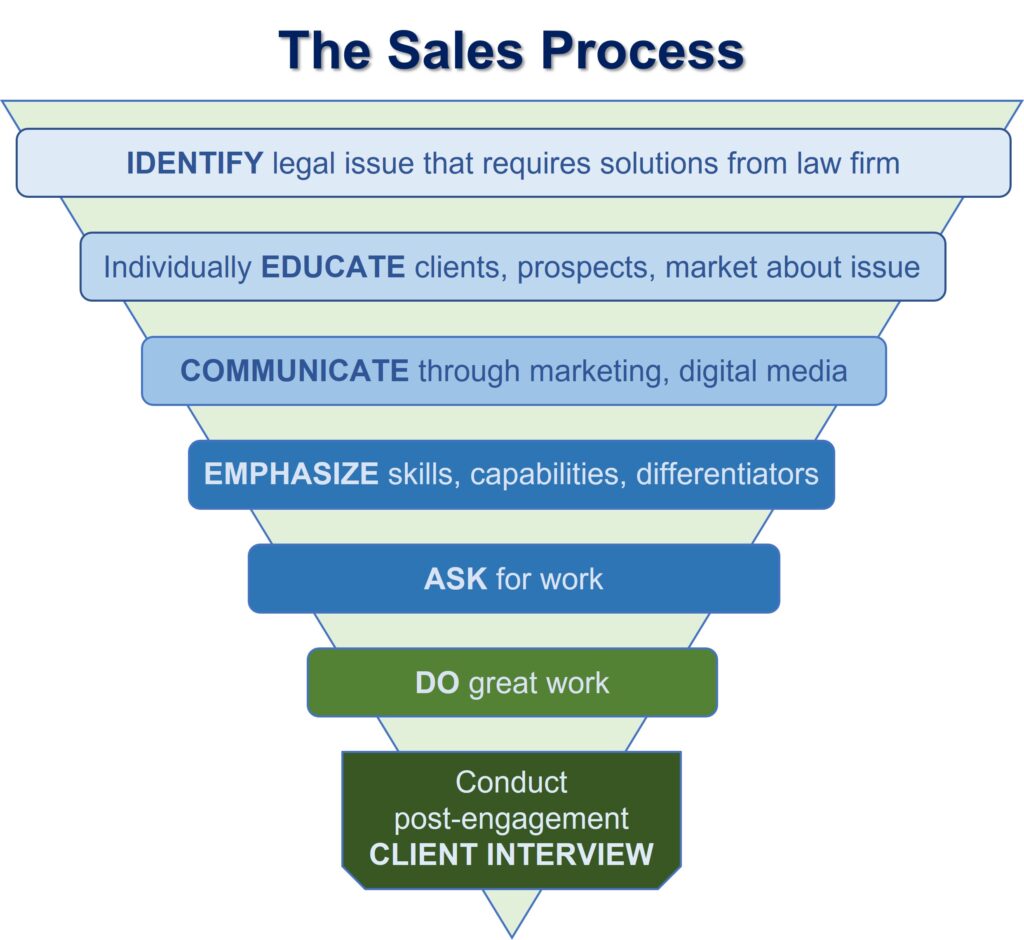“We can go about selling in a systematic way because there are repeatable processes in both buying and selling.”
This is an observation (with my emphasis) by Robert Miller, co-creator of the Miller-Heiman selling system, in the foreword to his book “Strategic Selling.”
In a few of my blog posts earlier this year (notably this one and this one), I covered how law firms might go about developing a sales process, so let’s focus now on the buying process to which Miller refers.
Here is a simple depiction of the process that in-house buyers use—written or not, consciously or not.

Start with this: There are no elective buys. Legal-services buyers make purchases only when they spot a problem, a need, or an opportunity that has legal implications. At that point, they consider ways to proceed, ranging from ignoring the issue to waiting for it to mature to handling it internally to turning to outside advisers.
After considering the options, they determine specifically how to address the issue. If they decide to use outside lawyers, buyers seek referrals from colleagues, friends, peers, and lawyers currently on the account, or they conduct an online search. When the provider is selected, an engagement agreement is executed, the assignment is undertaken and completed, payment is made, and the buyer evaluates the outcome and quality of service.
Depending on the complexity of the issue and the sophistication of the buyer, there are variations on this theme. But whether the buying model is simple, as in the illustration, or more complex, it provides law firms with a template for creating the complementary sales process.
Based on the buying process illustrated above, the complementary law firm sales process might be:

Here’s how it rolls: Through service to existing clients or through reading and research, a lawyer spots an issue likely to affect clients and prospective clients. The lawyer directly informs clients and prospective clients about the danger or opportunity. Using marketing communications, the firm spreads the word more broadly. When a firm finds clients or prospects interested in the issue, it actively reaches out to them via digital nurturing or human contact. To help the buyer with the purchase decision, the law firm stresses its capabilities, experience, strengths, and differentiators with respect to the issue. If this process is followed with discipline, lawyers are in a great position to directly ask buyer(s) for the assignment. When the result is a win, law firms then need to do what they do best: deliver outstanding service. At the conclusion of an engagement, they should elicit the client’s evaluation of the outcome and the quality of service provided.
Here are a few additional steps that law firms can take in order to better understand the buying process.
- Regularly ask for clients’ and prospective clients’ about buying policies and procedures.
- Seek to develop relationships not only with the primary buyer but with buying influencers, including procurement officers and, importantly, support staff such as paralegals and administrative assistants.
- Evaluate the firm’s recent wins, and reverse-engineer the buying process to better understand how these wins were achieved.
- Add questions about the buying process (and how the firm was selected) to post-engagement client interviews.
LawVision’s business development consultants have served as the most senior sales and business development officers at large law firms, and they have extensive experience helping clients understand the buying process and developing effective sales processes. For more information, contact LawVision Partner Steve Bell at (202) 421-5988.
Posted In


